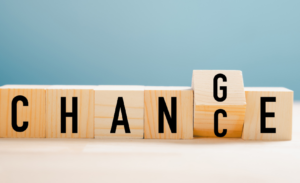2020 has created significant disruption in many areas of our world and accelerated the pace of change. Most experts agree that changes wrought by the COVID-19 pandemic have significantly altered the landscape, ushering in transformative change faster than we can say “Zoom”.
 Now, more than ever, being agile is a differentiating capability for most organizations. In a Harvard Business Review article, John Kotter writes:
Now, more than ever, being agile is a differentiating capability for most organizations. In a Harvard Business Review article, John Kotter writes:
“We can’t keep up with the pace of change, let alone get ahead of it. At the same time, the stakes—financial, social, environmental, political—are rising. The hierarchical structures and organizational processes we have used for decades to run and improve our enterprises are no longer up to the task of winning in this faster-moving world.”
Being agile when managing change is crucial to meet the needs of this transformative climate, enabling people to adopt changes that are business critical. But what does it mean to manage change in an agile way? Lena Ross shares several ways to be effective in navigating agile change that resonate with the way our team approaches agile change with clients:
- Understand trends and forces at work. Ross calls this the understanding of “Future of Work” to connect people to a purpose and a bigger picture. This translates to reminding people about the “why” for change, helping them get the vision of what will be different when transformation is done and what success looks like.
- Use Design Thinking. Here’s a great definition of Design Thinking from the Interaction Design Foundation: it’s a way to design our work to“help us systematically extract, teach, learn and apply these human-centered techniques to solve problems in a creative and innovative way.” In essence, Design Thinking is a process for creative problem-solving. Now more than ever, finding creative solutions to complex problems is essential.
- Utilize an agile mindset. Being agile means approaching change in a nimble and flexible way. One practical way this plays out is not trying to perfect a plan to anticipate everything that could happen 6 months from now. Instead, you’re constantly seeking new information, learning, experimenting to understand what works, and flexing your solutions to adapt based on what you’re learning over time.
- Create digital literacy. Now more than ever, we rely on digital proficiency to get work done as we navigate the COVID-19 pandemic. Leveraging technology to communicate, engage, co-create, and learn is essential now more than ever. Our team are fans of great collaboration tools like MS Teams, Slack, Zoom, and Trello as we manage change for clients.
- Understand human hardwired behavior. Ross writes that “The increased use of neuroimaging technology means that 90% of what we know about the brain has only been discovered in the last seven to nine years”. Utilizing neuroscience research is key for change practitioners to understand how people will react to change. For example, research has shown that people are wired to experience ambiguity and uncertainty as “pain”, which creates a strong and constant desire for certainty – so a fundamental understanding of this can help you plan your communications and engagement to address questions at the right time.
Sheri Browning is a Partner at PeopleResults. You can reach her at sbrowning@people-results.com or on Twitter @sbPResults



